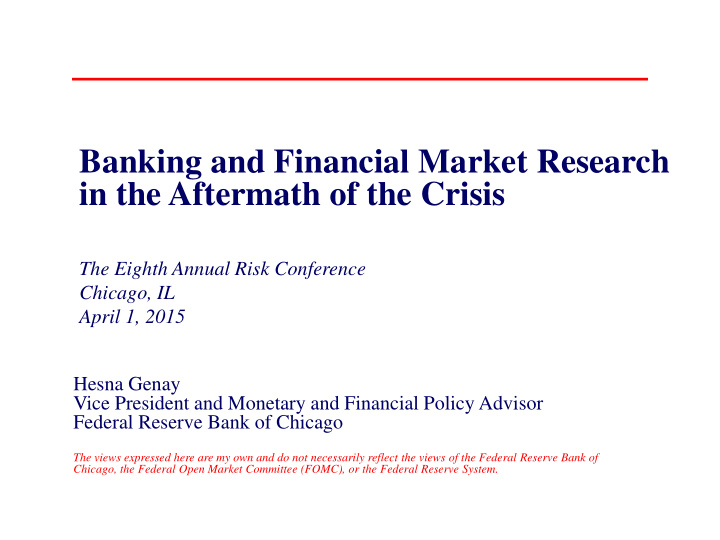



Banking and Financial Market Research in the Aftermath of the Crisis The Eighth Annual Risk Conference Chicago, IL April 1, 2015 Hesna Genay Vice President and Monetary and Financial Policy Advisor Federal Reserve Bank of Chicago The views expressed here are my own and do not necessarily reflect the views of the Federal Reserve Bank of Chicago, the Federal Open Market Committee (FOMC), or the Federal Reserve System. 1 1 1
Before the Crisis Beyond the supervisory and regulatory process, lots of interactions between policymakers, financial market participants, and academics Financial market developments – one of the key inputs to monetary policy process Contact calls with industry participants, surveys (Beige Book, Senior Loan Officer Opinion Survey) Advisory councils, Board of Directors of Reserve Banks Conferences 2 2 2
During and In the Aftermath of the Crisis More intensive monitoring of financial markets Outreach to a broader group of financial market participants Much greater academic interest Analyses of more granular data Explosion of research on banking and financial issues 3 3 3
Assessing Overall Financial Conditions Chicago Fed National Financial Conditions Index (NFCI; weekly updates @chicagofed.org) deviation from trend, 105-variable index 6 3 0 20-Mar-2015: -0.78 -3 1973 '78 '83 '88 '93 '98 '03 '08 '13 4 4 4
Overall Financial Conditions Predict real activity and likelihood of future economic downturns and financial stress periods well Nonfinancial Leverage sub-index of NFCI – good forecaster of financial stress and recessions 2-3 years ahead (Brave and Butters, 2012; Chicago Fed Letter ) Critical values for predicting: – Financial stress: 0.25 – Recessions: 0.99 Current value: -0.46 Similar results: Carlson, King, and Lewis (2011); Gilchrist and Zakrajšek (2012), etc. 5 5 5
Liquidity and Credit Risk Impact on bank funding costs during and post crisis (King and Lewis, 2014; Chicago Fed working paper) Liquidity risk: largest component of Libor spreads, especially at longer maturities Variation in credit risk component is largely due to changes in the sensitivity of Libor to credit risk, rather than changes in the level of credit risk 6 6 6
Managing Liquidity Shocks During the Crisis Cetorelli and Goldberg -- Liberty Street Economics , @newyorkfed.org Large, non-global US banks – share of core deposits in bank funding is key determinant of how funding shocks affect domestic loan growth Global US banks – Use internal capital markets (borrowing and lending from foreign affiliates) to cushion the impact of funding shocks – More important for banks with large unused commitments and low Tier 1 capital ratios Official facilities during the crisis moderated the impact of liquidity shocks on bank funding costs and lending. 7 7 7
Interest Rates and Bank Profitability Genay and Podjasek (2014, Chicago Fed Letter ) Higher interest rates, higher bank profits Small banks (TA < 100M) Large Banks (TA > 10B) +100 bp in: NIM ROA NIM ROA 3-month Treasury +1.5bp negligible +0.3 bp ~1 bp Rate 10-year/3- month negligible +1.8 bp +0.8 bp ~3.5 bp Treasury Spread 8 8 8
Interest Rates and Bank Profitability But, economic conditions matter even more 1 percentage-point decline in the unemployment rate: – 9 bp increase in bank ROA – 3x the largest impact of a comparable increase in the term spread – 6x the largest impact of a comparable increase in the short- term rate 8 percentage-point increase in house prices: – 5 bp increase in ROA 9 9 9
Other Research Topics of Potential Interest Measures of systemic risk of individual banks and network analysis of interconnectedness – Counter-party risk Impact of higher capital requirements on: bank lending, bank profits, and real activity Evolution of bank business models and effects on their crisis management High frequency trading, financial market utilities Effects of mortgage modifications (including HARP) on incidence of defaults, bank profits, etc. The European crisis and bank funding costs and activities 10 10 10
Recommend
More recommend